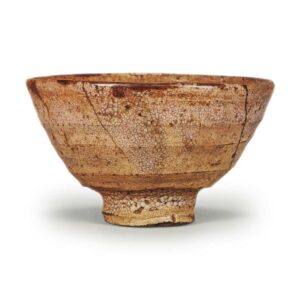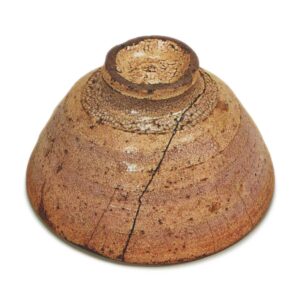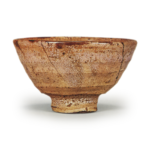

Daimyo-mono
Height: 8.5cm
Diameter: 15.3cm
Outer diameter of foot ring: 5.2cm
Height of foot ring: 1.4cm
The origin of the name Matsunaga is unclear. It is thought that the name comes from the fact that it was owned by Matsunaga Danjo Hisahide.
The foot of the cup is slightly lower than the rest of the cup, but this is probably because the foot was slightly polished to make it level after it had been leaning to one side. If it had been left at its original height, it would have had a more dignified appearance, with a strong, well-rounded rim.
The glaze is relatively thin, and therefore the craquelure is rather fine throughout. A little kaaragi glaze can be seen around the foot ring, but the inside of the foot ring is quiet.
The outer loquat-colored glaze is tinged with gray, and if anything, it has a subdued color sense, but there are some spots that look like they have been blown black, which create a landscape.
The inside of the bowl is slightly concave in the center, and there are four spots of different sizes where the eyes were. The inside glaze is also grayish and sober in color, but there are also scattered spots of grayish-brown color.
The rise from the foot to the rim is somewhat thin, but like the Hoshikawa, it shows a relaxed bowl-like expansion.
The overall impression is that, despite being a rather large tea bowl, it is not a powerful piece, but rather a dignified work that conceals its strength within.
In the tea bowl section of the Konoike family’s inventory book, which includes the entry “January 4th, Genroku 4th year, a good day”, it is noted that “one Matsunaga Ido, price 105 ryou, owned by Kobori Enshu-no-kami”, so it is known that it was once owned by Kobori Enshu. In the Taisho Meiki Kan (A Guide to Famous Tea Utensils of the Taisho Period), it is stated that the origin of the tea bowl is unknown, but as it was owned by Enshu Kobori, it is thought that the calligrapher of the box was probably Enshu Kobori, judging from the style of the calligraphy.
The outer box is inscribed by the calligrapher Hon’o, or Man’yodo Tan’no, but there are quite a few items in the Konoike family collection that are inscribed by Manpo, so it is likely that Manpo was asked to write the inscription during the time of the famous Konoike Michioku, who died in 1736. It is also thought that the aforementioned toolbook was made during the time of Michioku.
In the Kokin Meibutsu Ruiju (A Collection of Famous Ancient and Modern Objects) written in 1787, it is referred to as “Matsunaga Ido Kōnoike”, so the history of this tea bowl is not known in detail before the time of Enshū, but it is certain that it came into the possession of the Kōnoike family after Enshū owned it, and that it was passed down in the family until after the end of the war.
It was used at the Kōetsu-kai tea gathering in Nagoya in the fall of 1964 by the current owner, and it is certain that this tea bowl was used at tea gatherings like this one.








